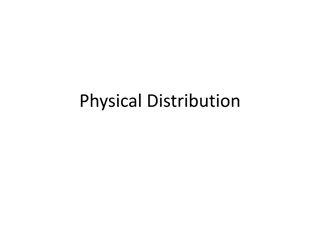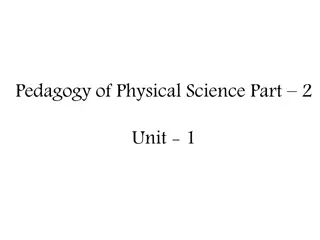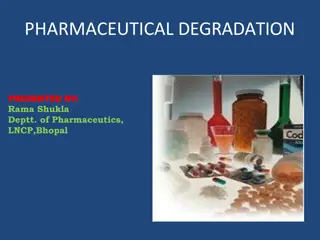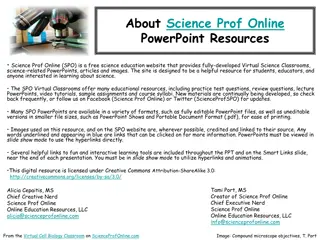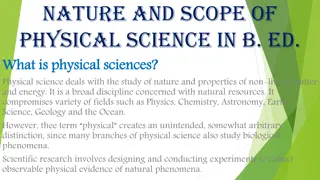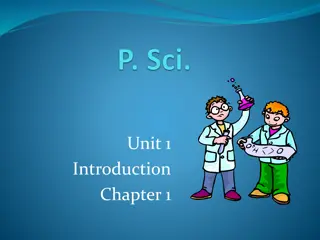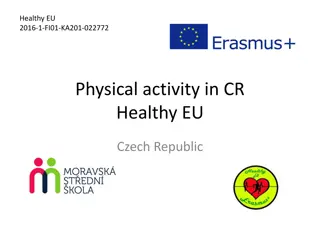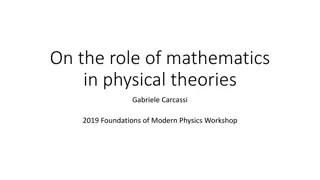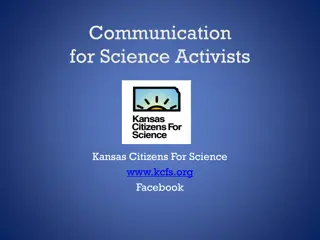Introduction to Physical Science
Explore the world of solutions in physical science through this detailed presentation by Robert Wagner. Learn about the basic properties of solutions, different types of solutions, the formation of solutions, electrolytes, and much more. Understand the concepts of solutes, solvents, homogeneity, and the factors affecting the formation of ideal solutions. Dive into the realm of physical chemistry and enhance your knowledge of how substances interact and mix at a molecular level.
Download Presentation

Please find below an Image/Link to download the presentation.
The content on the website is provided AS IS for your information and personal use only. It may not be sold, licensed, or shared on other websites without obtaining consent from the author.If you encounter any issues during the download, it is possible that the publisher has removed the file from their server.
You are allowed to download the files provided on this website for personal or commercial use, subject to the condition that they are used lawfully. All files are the property of their respective owners.
The content on the website is provided AS IS for your information and personal use only. It may not be sold, licensed, or shared on other websites without obtaining consent from the author.
E N D
Presentation Transcript
Introduction to Physical Science Solutions Presented by Robert Wagner
Basic Properties of Solutions Definition of a solution: Homogeneous mixture of two or more substances Solvent vs. Solute Solvent - component present in a much greater concentration Solute - component present in lesser concentration
Solution Examples Sucrose (sugar) ?12?22?11(?) ?12?22?11(??) Sucrose molecules are solutes - spread through out the solution Potassium dichromate (?2??2?7) ?2??2?7(?) 2?+(??) + ??2?7 Dissociates in water - solutes are both potassium and dichromate ions 2 (??)
Properties & Types of Solutions A solution can be a solid, liquid or gas. Properties Homogeneous Physical state of solution is the same as that of the solvent Components are dispersed on a molecular scale Solvent will not settle out Concentrations can be varied continuously Image Credit: OpenStax Chemistry - Table 11.1 CC BY 4.0
Formation of Solutions Spontaneous process(no external energy source needed) Decrease in internal energy Increase in entropy Ideal solution No change in energy Image Credit: OpenStax Chemistry - Figure 11.3 CC BY 4.0
Electrolytes Definition of electrolytes Substances that yield ions when dissolved in a solution Strong vs. Weak Electrolytes Strong electrolytes - Process producing ions is essentially 100% efficient Weak electrolytes - Process producing ions is much less than 100% efficient Image Credit: OpenStax Chemistry - Figure 11.6 CC BY 4.0
Ionic Electrolytes Polar molecule like water are attracted to ions Ion-dipole attraction Dissociation - a physical process Nearly complete dissolution => strong electrolytes Image Credit: OpenStax Chemistry - Figure 11.7 CC BY 4.0
Covalent Electrolytes Water - poor conductor of electricity - very slightly ionized ?2?(?) + ?2?(?) ?3?+(??) + ?? (??) Hydrochloric Acid (HCl) ?2?(?) + ???(?) ?3?+(??) + ?? (??) Strong acid - strong electrolyte Weak acid - weak electrolyte
Summary A solution is a homogeneous mixture of two or more substances - it can be a solid, liquid or gas The spontaneous formation of a solution will generally cause a decrease in the internal energy and/or an increase in the entropy of the system Electrolytes can be strong or weak depending on the level of dissociation of the ions in solution



